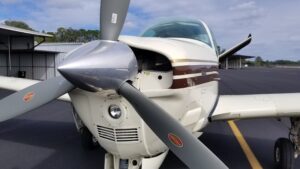 Between regulatory changes allowing technically advanced aircraft to be used instead of complex aircraft and the rising popularity of aircraft that adopt a Full Authority Digital Engine Control System (FADEC), many flight students are never required to fly aircraft with a propeller control (the blue lever). Training aircraft, such as the Diamond DA42 NG, operate using FADEC with a single power lever, and other aircraft, such as a Cirrus, control the propeller pitch through direct linkages with the throttle.
Between regulatory changes allowing technically advanced aircraft to be used instead of complex aircraft and the rising popularity of aircraft that adopt a Full Authority Digital Engine Control System (FADEC), many flight students are never required to fly aircraft with a propeller control (the blue lever). Training aircraft, such as the Diamond DA42 NG, operate using FADEC with a single power lever, and other aircraft, such as a Cirrus, control the propeller pitch through direct linkages with the throttle.
Rather than discussing the pros and cons of each configuration, the purpose of this article is to provide basic knowledge for the benefit of pilots who have trained in a complex or technically advanced aircraft without ever using a propeller control lever. Developing a keen understanding of the topic can accelerate the transition training necessary to familiarize yourself with a traditional aircraft that has a controllable-pitch propeller.
Clear Differences
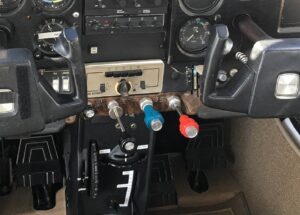 A traditional fixed-pitch propeller aircraft has a throttle (black knob or lever) and a mixture control (red knob or lever). An airplane with a controllable-pitch propeller, also known as a constant-speed prop, has an additional blue knob or lever that is often placed between the throttle and mixture control levers. An aircraft with a FADEC system reduces the count to one lever that uses a computer to automatically control the throttle, propeller pitch, and fuel/air mixture, much like the single gas pedal on an automatic vehicle. Aircraft with controllable-pitch propellers require additional considerations when increasing or decreasing power. For example, cruise charts require you to consider not only altitude and RPM, like on fixed-pitch propeller aircraft, but also the manifold pressure (MP).
A traditional fixed-pitch propeller aircraft has a throttle (black knob or lever) and a mixture control (red knob or lever). An airplane with a controllable-pitch propeller, also known as a constant-speed prop, has an additional blue knob or lever that is often placed between the throttle and mixture control levers. An aircraft with a FADEC system reduces the count to one lever that uses a computer to automatically control the throttle, propeller pitch, and fuel/air mixture, much like the single gas pedal on an automatic vehicle. Aircraft with controllable-pitch propellers require additional considerations when increasing or decreasing power. For example, cruise charts require you to consider not only altitude and RPM, like on fixed-pitch propeller aircraft, but also the manifold pressure (MP).
Why Should You Bother?
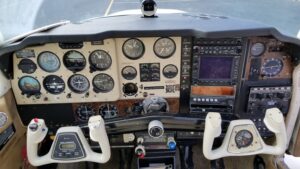 The purpose can be described in a single word—efficiency. Fixed-pitch propellers provide suitable performance in a narrow range of airspeeds; however, efficiency suffers considerably outside this range. To provide better propeller efficiency through different phases of flight, the pilot should be able to control the pitch of the propeller blades, and the most effective way to do so is by means of a constant-speed governing system.
The purpose can be described in a single word—efficiency. Fixed-pitch propellers provide suitable performance in a narrow range of airspeeds; however, efficiency suffers considerably outside this range. To provide better propeller efficiency through different phases of flight, the pilot should be able to control the pitch of the propeller blades, and the most effective way to do so is by means of a constant-speed governing system.
What it Controls
The propeller lever (blue lever) controls the pitch of the propeller, which can be used to increase its efficiency. Moving the prop control changes the RPM (shown on the tachometer), and the power is controlled by the throttle and monitored on the manifold pressure gauge, which is read in inches of mercury, similar to a barometer. This is an important difference for pilots transitioning from an airplane with a fixed-pitched propeller, who are accustomed to using the RPM read from the tachometer to set power.
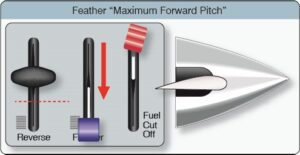 Except for a full-feathering turboprop, the blades typically rest at a low-pitch angle, which produces a high RPM when the engine is operating. Visualize the pitch as being low, or flat, in reference to the arc in which the propeller spins. Since the blades have a lower angle of attack, the prop spins at a faster RPM. When the prop control level is reduced (pulled back), the pitch of the blades increases, which lowers the RPM: remember “High Pitch, Low RPM.” When you pull the lever all the way back, this causes the blades to feather (or nearly feather), which means the blades are angled almost horizontally. Push forward and the blades decrease in pitch, which increases RPM: remember “Low Pitch, High RPM.”
Except for a full-feathering turboprop, the blades typically rest at a low-pitch angle, which produces a high RPM when the engine is operating. Visualize the pitch as being low, or flat, in reference to the arc in which the propeller spins. Since the blades have a lower angle of attack, the prop spins at a faster RPM. When the prop control level is reduced (pulled back), the pitch of the blades increases, which lowers the RPM: remember “High Pitch, Low RPM.” When you pull the lever all the way back, this causes the blades to feather (or nearly feather), which means the blades are angled almost horizontally. Push forward and the blades decrease in pitch, which increases RPM: remember “Low Pitch, High RPM.”
Takeoffs
During takeoff, you want the engine at maximum thrust so as to generate sufficient speed before rotating. To achieve this with a constant-speed propeller (non-turbocharged engine), the prop lever is moved all the way forward to the low pitch/high RPM setting, along with the throttle for maximum allowable manifold pressure. The low blade angle keeps the AOA, with respect to the relative wind, small, allowing the propeller to handle a smaller mass of air per revolution. This light load allows the engine to turn at maximum RPM, generating maximum power.
Climbs
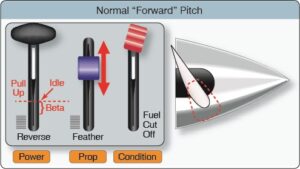 During the climb, some engines require the pilot to set maximum continuous RPM. To do so, the power and RPM need to be decreased by reducing the throttle and the propeller levers to the recommended settings found in the AFM/POH. As a general rule, the throttle should be reduced prior to the RPM being reduced. Many training airplanes require a climb setting of around 25 inches of manifold pressure (MP) and 2,500 RPM. Pilots may refer to this as “25-squared.”
During the climb, some engines require the pilot to set maximum continuous RPM. To do so, the power and RPM need to be decreased by reducing the throttle and the propeller levers to the recommended settings found in the AFM/POH. As a general rule, the throttle should be reduced prior to the RPM being reduced. Many training airplanes require a climb setting of around 25 inches of manifold pressure (MP) and 2,500 RPM. Pilots may refer to this as “25-squared.”
The order here is important, as reducing the RPM prior to reducing the power could cause excessive cylinder combustion pressures, resulting in high stresses within the engine. Additionally, excessive pressure also produces high engine temperatures. The combination of high manifold pressure and low RPM can cause detonation in the cylinders, which can be incredibly damaging. Refer to your AFM/POH for the settings required for your airplane.
Cruise
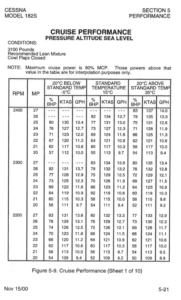 In cruise flight, less power is required to maintain desired cruise speeds. Plus, who doesn’t like to save fuel? To take advantage of the efficiencies afforded by a constant-speed engine, power will again be decreased by first reducing the throttle before reducing the prop RPM to the desired manifold pressure and RPM setting listed in the AFM/POH. The combination of manifold pressure and RPM settings has been exhaustively tested and approved by engineers. Refer to the performance charts listed in the AFM/POH for any limitations on acceptable combinations.
In cruise flight, less power is required to maintain desired cruise speeds. Plus, who doesn’t like to save fuel? To take advantage of the efficiencies afforded by a constant-speed engine, power will again be decreased by first reducing the throttle before reducing the prop RPM to the desired manifold pressure and RPM setting listed in the AFM/POH. The combination of manifold pressure and RPM settings has been exhaustively tested and approved by engineers. Refer to the performance charts listed in the AFM/POH for any limitations on acceptable combinations.
Approaches
When descending, power needs to be further decreased. While the throttle is reduced, the propeller RPM usually remains at the same setting used in cruise. Again, refer to your AFM/POH for the specific requirements and limitations of your aircraft. In some cases, you may need to descend at a steeper than normal angle. If needed, the propeller can act like a speedbrake by increasing the prop control. This low-pitch, high-RPM setting will cause more drag, allowing you to quickly slow down or maintain slower speeds during descent.
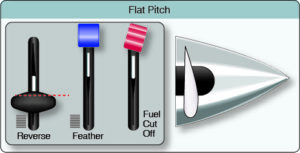 As you descend, keep an eye on the RPM and ensure that it does not overspeed beyond the red line. If it does, you should reduce the throttle even further to keep the RPM within the green arc. If you did not increase RPM during your descent, you’ll want to do that during your final approach. Doing so allows you to quickly apply maximum thrust (low pitch, high RPM) in the event of a go-around without causing a governor overspeed.
As you descend, keep an eye on the RPM and ensure that it does not overspeed beyond the red line. If it does, you should reduce the throttle even further to keep the RPM within the green arc. If you did not increase RPM during your descent, you’ll want to do that during your final approach. Doing so allows you to quickly apply maximum thrust (low pitch, high RPM) in the event of a go-around without causing a governor overspeed.
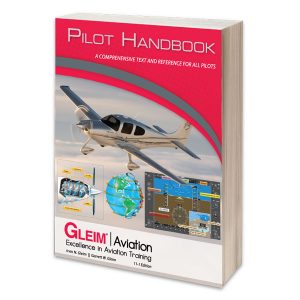 Whether you are transitioning from an aircraft with a fixed-pitched propeller to one with a controllable-pitch propeller, or you are a FADEC-skilled pilot who has always wondered how to work the multitude of levers in synchrony, we hope you learned more about the purpose and operation of “the blue lever.” For more information on the controllable-pitch propellers and FADEC systems, grab a copy of the Gleim Pilot Handbook, where we elaborate on these topics in Chapter 2.
Whether you are transitioning from an aircraft with a fixed-pitched propeller to one with a controllable-pitch propeller, or you are a FADEC-skilled pilot who has always wondered how to work the multitude of levers in synchrony, we hope you learned more about the purpose and operation of “the blue lever.” For more information on the controllable-pitch propellers and FADEC systems, grab a copy of the Gleim Pilot Handbook, where we elaborate on these topics in Chapter 2.
Written by: Ryan Jeff (CFI, AGI), Aviation Research Assistant

